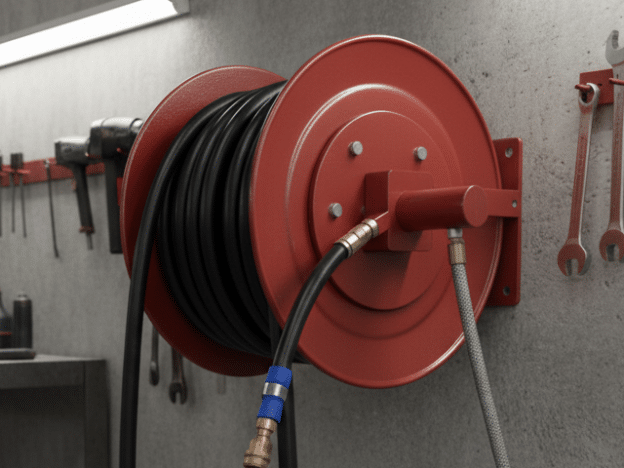A safe and organized workspace depends on the right tools, and the air hose reel plays an important part in that setup. It keeps hoses off the floor, reduces tripping hazards, and helps maintain a clean, efficient environment. Knowing which safety features matter most helps protect both people and equipment from preventable accidents.
Not all air hose reels offer the same level of safety. Some materials resist corrosion better, some mechanisms control hose movement more effectively, and others handle higher air pressures with less risk. By understanding what to look for, anyone can choose a reel that supports safe and consistent operation in demanding work conditions.
Durable, corrosion-resistant reel material to withstand harsh environments
A safe air hose reel must use materials that resist rust and wear. Moisture, salt, and chemicals can damage metal parts over time, so the reel body should be made of stainless steel, aluminum, or powder-coated steel. These materials help prevent corrosion and extend the reel’s working life in outdoor or industrial areas.
Some designs use stainless steel grades such as SS304, which handle contact with water, oil, and cleaning agents without breaking down. This makes them suitable for workshops, marine settings, and food processing areas where exposure to moisture is common.
For users who need lightweight strength, aluminum reels offer a good balance of durability and portability. Powder-coated steel reels also perform well because the coating adds another layer of protection against rust and fading.
A hybrid polymer air hose reel can also resist cracking and temperature changes better than basic rubber or PVC hoses. The hybrid material stays flexible in both hot and cold weather, which helps maintain safe and steady air pressure during use.
Selecting a corrosion-resistant reel material reduces repair costs and keeps the equipment safe for daily operation. It also prevents leaks or hose damage that could cause accidents or delays in work.
Automatic retractable mechanism to prevent hose tangling and tripping hazards
An automatic retractable mechanism allows the air hose to pull back into the reel at a controlled speed. This feature keeps the hose organized and off the floor, which reduces the chance of someone stepping on it or tripping. It also saves time because the user does not need to coil the hose by hand after each use.
The system usually relies on spring tension and a locking device. The spring creates the force that draws the hose back, while the lock holds it in place until the user releases it. This design helps the hose return smoothly instead of snapping back, which can cause injury or damage nearby objects.
A slow retraction feature adds another layer of safety. It allows the hose to rewind at a steady pace, avoiding sudden whip action. This prevents both the hose and the fittings from wearing out too quickly.
By keeping the hose neatly stored, the reel also helps maintain a clean and organized workspace. A clear floor area reduces clutter and makes movement safer for anyone working nearby. Therefore, the automatic retractable mechanism not only improves convenience but also supports a safer and more efficient environment.
Pressure rating compliance guarantees safe operation under specified air pressures
Each air hose reel must match the pressure rating of the compressor and connected equipment. The pressure rating shows the maximum amount of air pressure the reel can handle without damage or failure. Using a reel below the system’s rated pressure can cause leaks, bursts, or unsafe working conditions.
Manufacturers test and label reels with a specific pressure limit, often shown in pounds per square inch (psi). Operators should always confirm that the reel, hose, and fittings share the same or higher pressure rating as the compressor. This check helps maintain safe operation and prevents strain on the system.
Regular inspection supports safe performance. Hoses, couplings, and valves should show no cracks, corrosion, or weak spots. If any part appears worn, it should be replaced before use to avoid sudden pressure loss or hose separation.
Proper labeling also plays an important role. Clear identification of the maximum working pressure on pipelines and reels helps employees select the right equipment for each task. This practice reduces confusion and supports compliance with safety standards.
In addition, consistent maintenance keeps the air system stable. Checking pressure gauges, relief valves, and fittings verifies that the system operates within its designed limits. A well-maintained reel not only protects workers but also extends the life of the equipment.
Conclusion
An air hose reel plays a direct role in workplace safety by keeping hoses organized and off the floor. This reduces tripping hazards and helps maintain a cleaner, more efficient work area.
The most effective models include slow retraction control, durable housing, and a secure locking system. Each feature adds a layer of safety that protects both workers and equipment.
By choosing a reel with these key features, a workshop gains safer operation, longer hose life, and fewer accidents. These simple design choices make daily tasks smoother and safer for everyone.


